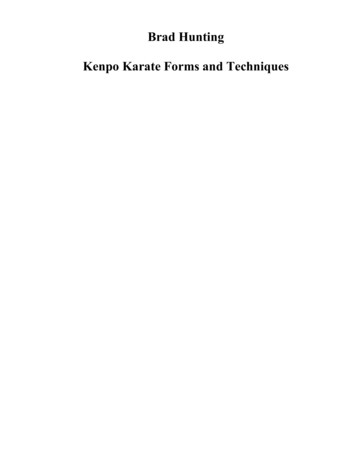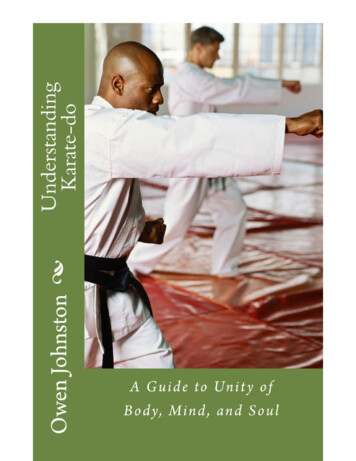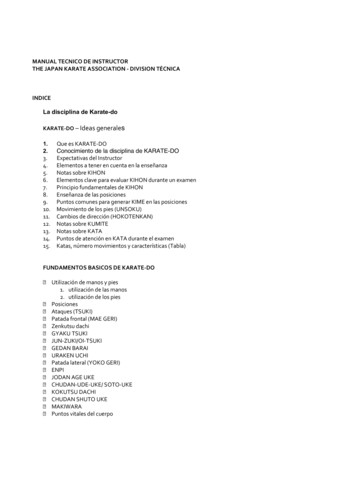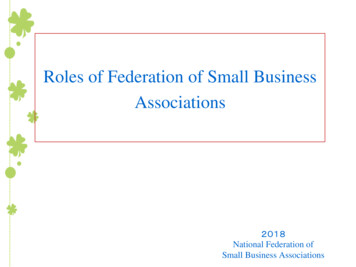
Transcription
OFFICIAL WTOKF COMPETITION & REGULATION RULES BOOKAdopted 3/01/2015Revised 12/04/2016WORLD TRADITIONAL OKINAWAKARATE FEDERATIONOFFICIAL KARATE-DOCOMPETITION & REGULATIONRULES BOOK“Through the experience of competition, athletes, andofficials learn to endure challenges that strengthens theirsoul, and achieve success that polishes their character.”1
OFFICIAL WTOKF COMPETITION & REGULATION RULES BOOKDel Saito SokePREFACEIn harmony with the spirit of martial arts, these competitionrules include the technical principles and philosophy of traditionalKarate-do. It is also very important that the WTOKF rules closelyfollow the rules of the World Karate Federation, the authorizedInternational body approved by International OlympicCommittee. Karate has been admitted into the Olympics in 2020Games, so in order to give our athletes an opportunity for futureOlympic participation, it is only prudent to familiarize them withthe International rules.The mission of the WTOKF Karate-do Competition Program isto offer quality competition and training as a supplement to thegeneral WTOKF Karate-do organization; to enhance the physical,mental and moral development of all athletes; to provide anavenue for competition on a local, national and world level; tointegrate a curriculum that will encourage our athletes to choosea drug-free lifestyle; to showcase WTOKF Karate champions,instructors, coaches, officials as role models; and to promote goodsportsmanship, good citizenship and safety. The WTOKF Karatedo Competition Program shall carry out its mission by:Conducting programs that provide for, enhance andstrengthen participation and competition for amateur athletes.2
OFFICIAL WTOKF COMPETITION & REGULATION RULES BOOKWorking with other sports organizations to benefit our maleand female amateur athletes.Conducting grass roots programs in every participatingcountry and encouraging Local, RegionalandNationalcompetitions.Conducting recognition programs for athletes and toestablish an International WTOKF Karate Hall of Fame to recognizeoutstanding members who exhibit leadership, high moralcharacter, sportsmanship and ideals of karate-do.To provide information and education to WTOKF membersthrough the publication of a newsletter and distribute informationthrough the internet and through the use of the WTOKF web site.TO INVITE ALL TRADITIONAL STYLES TO PARTICIPATE IN OUREVENTS.These rules are also adopted to ensure the physical integrityof the athletes, to assure fairness, and good sportsmanship and tominimize discrepancies of the officials.These rules represent the essence of WTOKF that augmentsthe historical evolution of karate-do.These rules are also implemented as a "guide" for futuregenerations of the WTOKF. They represent the origin in traditional3
OFFICIAL WTOKF COMPETITION & REGULATION RULES BOOKkarate, with amendments that also reflects the current technicallevel of karate in the world.In the spirit of martial arts the competitions rules mustrepresent the technical principles and the philosophy of discipline.Contest rules are designed in order to ensure the physicalintegrity of the athletes to reduce the human error by the refereesand to increase the collective consciousness in consideration ofwhat Karate means both individually and collectively. WTOKFconcept is to keep developing and promoting worldwide thetraditional Japanese Budo, practically those of OKINAWA KARATEdescent.The new historical stage of the development of the karateimposes respect regarding the unity of the Okinawa Karate andJapanese styles, working together to provide education andtraining, to inform the students about all the aspects of rules andprinciples and to preserve and promote the Japanese culture,Budo and the Japanese heritage worldwide.Thanks to the work of the great masters these rules areconstantly and continually improved, we set clear the rules thatcontain the essence and basic principles of the karate.Therefore, these rules can be considered as a "guide" for thefuture generations of practitioners of karate. These rules havetheir roots in the traditional Japanese karate: the OKINAWAKARATE with specific changes that reflect harmoniously the4
OFFICIAL WTOKF COMPETITION & REGULATION RULES BOOKcurrent technical level of the karate in the world. These rules areconceived and intended for the Karate Championships andCompetitions.PRESIDENTHanshi IONEL BARA9 DANOkinawa KarateFounder of WTOKFOfficial Competition Rules and Regulations Hand BookPublished byWORLD TRADITIONAL OKINAWA KARATE FEDERATIONCOMPETITION PROGRAMIONEL BARA - WTOKF President & FounderDEL S. SAITO - WTOKF Vice-President & Technical AdvisorWTOKF Headquarters: 41-44-787-0213www.wtokf.org5
OFFICIAL WTOKF COMPETITION & REGULATION RULES BOOKCONTENTS:GENERAL KUMITE RULESARTICLE 1:ARTICLE 2:ARTICLE 3:ARTICLE 4:ARTICLE 5:ARTICLE 6:ARTICLE 7:ARTICLE 8:ARTICLE 9:ARTICLE 10:ARTICLE 11:ARTICLE 11:ARTICLE 12:ARTICLE 13:ARTICLE 14:KUMITE COMPETITION AREAOFFICIAL DRESS (Referees, Coaches, Contestants)ORGANIZATION OF KUMITE COMPETITIONSTHE REFEREE PANELDURATION OF BOUTSCORINGCRITERIA FOR DECISIONPROHIBITED BEHAVIORWARNINGS & PENALTIESINJURIES AND ACCIDENTS IN COMPETITIONOFFICIAL PROTESTOFFICIAL PROTESTREFEREE COMMISSION (Tatami Managers,Referees, Judges, Match Supervisor)STARTING, SUSPENDING AND ENDING OFMATCHESMODIFICATIONSSHOBU IPPON KUMITE RULESARTICLE 1:ARTICLE 2:DEFINITIONPROCEDURE6
OFFICIAL WTOKF COMPETITION & REGULATION RULES BOOKJYU IPPON KUMITE RULESARTICLE 1:ARTICLE 2:DEFINITIONPROCEDUREKATA RULESARTICLE 1:ARTICLE 2:ARTICLE 3:ARTICLE 4:ARTICLE 5:ARTICLE 6:KATA COMPETITION AREAOFFICIAL DRESSORGANIZATION OF KATA COMPETITIONTHE JUDGING PANELCRITERIA FOR EVALUATIONOPERATION OF MATCHESKATA BUNKAI/OYO RULESARTICLE 1:ARTICLE 2:DEFINITIONPROCEDUREKOBUDO RULESARTICLE 1:ARTICLE 2:ARTICLE 3:ARTICLE 4:KOBUDO COMPETITION AREAOFFICIAL DRESSORGANIZATION OF KOBUDO COMPETITIONTHE JUDGING PANEL7
OFFICIAL WTOKF COMPETITION & REGULATION RULES BOOKARTICLE 5:ARTICLE 6:ARTICLE 7:CRITERIA FOR EVALUATIONOPERATION OF MATCHESGENERAL INFORMATIONAPPENDIXESAPPENDIX 1:APPENDIX 2:APPENDIX 3:APPENDIX 4:APPENDIX 5:APPENDIX 6:APPENDIX 7:TERMINOLOGYOPERATIONAL GUIDELINES FOR REFEREES ANDJUDGESSCOREKEEPERS MARKSLAYOUT OF THE KUMITE COMPETITION AREALAYOUT OF THE KATA COMPETITION AREATHE KARATE GIREFEREES GESTURES AND JUDGES FLAG SIGNALSANNOUNCEMENTS AND GESTURES OF THE REFEREETHE JUDGE’S FLAG SIGNALSAPPENDIX 8:WTOKF KARATE-DO COMPETITION PROGRAMCOMMITTEE STRUCTURE:EXECUTIVE COMMITTEEDIRECTORSECRETARYTREASURERAPPENDIX 9: TECHNICAL ADVISORY COMMITTEEAPPENDIX 10: COACHES’ COMMITTEEAPPENDIX 11: TEMPORARY COMMITTEESAPPENDIX 12: MEDICAL COMMISSION8
OFFICIAL WTOKF COMPETITION & REGULATION RULES BOOKAPPENDIX 13:APPENDIX 14:APPENDIX 15:APPENDIX 16:APPENDIX 17:APPENDIX 18:APPENDIX 19:APPENDIX 20:APPENDIX 21:APPENDIX 22:APPENDIX 23:APPENDIX 24:APPENDIX 25:APPENDIX 26:APPENDIX 27:APPENDIX 28:DECLARATION OF FAIRNESSWEIGHT CLASSIFICATIONEXPERIENCE LEVELS FOR CHAMPIONSHIPSTHE MINIMUM OFFICIAL REQUIREMENTS FORTOURNAMENTS OTHER THAN WORLD CHAMPS.OFFICIAL KOBUDO KATA LISTPROTEST FORMCHART TO DETERMINE AMOUNT OF BYESINJURY REPORT FORMKUMITE, KATA & KOBUDO FLAG JUDGEMENTCHARTS INCLUDING REPECHAGEKUMITE SCORE CHARTOFFICIALS’ CLASSIFICATIONCOACHES, MANAGERSKARATE COMPETITION FOR 14 YEARS & UNDERFINAL PROVISIONSATHLETES’ OATH OF HONOROFFICIALS’ OATHNOTE: It should be noted that the male gender used in this textalso refers to the female.9
OFFICIAL WTOKF COMPETITION & REGULATION RULES BOOKGENERAL KUMITE RULESARTICLE 1: KUMITE COMPETITION AREA1. The competition area must be flat and devoid of hazard.2. The competition area will be a matted square, of a WTOKFapproved type, with sides of eight meters (measured from theoutside) with an additional one meter on all sides as a safety area.There will be a clear safety area of two meters on each side.3. Two mats are inverted with the red side turned up in a onemeter distance from the mat center to form a boundary betweenthe contestants.4. The Referee will be standing centered between the two matsfacing the Competitors at a distance of one meter from the safetyarea.5. Each judge will be seated at the corners on the mat in the safetyarea. The referee may move around the entire tatami, includingthe safety area where the judges are seated. Each judge will beequipped with a red and a blue flag.6. The Match Supervisor will be seated just outside the safetyarea, behind, and to the left or right of the Referee. He will beequipped with a red flag or sign, and a whistle.10
OFFICIAL WTOKF COMPETITION & REGULATION RULES BOOK7. The score-supervisor will be seated at the official score table,between the scorekeeper and the timekeeper.8. Coaches will be seated outside the safety area, on theirrespective sides at the side of the tatami towards the official table.Where the tatami area is elevated, the coaches will be placedoutside the elevated area.9. The one meter border should be in a different color from therest of the matted area.10. The competition area should be thoroughly ventilated with arecommended inside temperature from 15 to 24 degree C. (60F 75F)EXPLANATION:I. There must be no advertisement hoardings, walls, pillars etc.within one meter of the safety area's outer perimeter.II. The mats used should be non-slip where they contact the floorproper but have a low co-efficient of friction on the uppersurface. They should not be as thick as Judo mats, since thesemay be hazardous for Karate movements. The Referee mustensure that mat modules do not move apart during thecompetition, since gaps cause injuries and constitute a hazard.They must be of approved WTOKF design.11
OFFICIAL WTOKF COMPETITION & REGULATION RULES BOOKARTICLE 2: OFFICIAL DRESS1. Contestants and their coaches must wear the official uniform asherein defined.2. The Referee Commission may disbar any official or competitorwho does not comply with this regulation.REFEREES1. Referees and Judges must wear the official uniform designatedby the Referee Commission. This uniform must be worn at alltournaments and courses.2. The official uniform will be as follows:A black hakama pants with a dark blue keikogi top for 18 -34 yearold M/F Advanced Senior Divisions.For all other divisions:The official uniform will be as follows:A single breasted navy-blue blazer bearing two silverbuttons.A white shirt with short sleeves.An official WTOKF tie worn without tie pin.Plain light gray trousers without cuffs.An official WTOKF badge.An officials’ license book with their name and licenserating.Unpatterned dark blue or black socks and black, slipon shoes for use on the match area.Jewelry of any kind is not allowed, including watches,wedding rings and stud earrings.12
OFFICIAL WTOKF COMPETITION & REGULATION RULES BOOKAll officials must present their license credentials to the ChiefReferee or Council of Referees prior to the commencement of theopening ceremonies.All officials shall bring a whistle attached to a white chord, penand writing pad.No jewelry.Female Referees and Judges may wear a hair clip andreligiously mandated headwear approved by the WTOKF.This uniform will also be worn at all referee’s courses.CONTESTANTS1. Contestants must wear a white karate gi without stripes, pipingor personal embroidery. The national emblem or flag of thecountry will be worn on the left breast of the jacket and may notexceed an overall size of 12cm by 8cm (see Appendix 6). Only theoriginal manufacturer’s labels may be displayed on the gi. Inaddition, identification issued by the Organizing Committee willbe worn on the back. One contestant must wear a red belt and theother a blue belt. The red and blue belts must be around fivecentimeters wide and of a length sufficient to allow fifteencentimeters free on each side of the knot. The belts are to be ofplain red and blue color, without any personal embroideries oradvertising or markings other than the customary label from themanufacturer.2. Notwithstanding paragraph 1 above, the Executive Committeemay authorize the display ofspecial labels or trademarks ofapproved sponsors.13
OFFICIAL WTOKF COMPETITION & REGULATION RULES BOOK3. The jacket, when tightened around the waist with the belt, mustbe of a minimum length that covers the hips, but must not bemore than three-quarters thigh length. Female competitors maywear a plain white T-shirt or white sports bra beneath the Karatejacket. Jacket ties must be tied. Jackets without ties may not beused.4. The maximum length of the jacket sleeves must be no longerthen the bend of the wrist and no shorter than halfway down theforearm. Jacket sleeves may not be rolled up except for Kobudoevents.5. The trousers must be long enough to cover at least two thirdsof the shin and must not reach below the anklebone. Trouser legsmay not be rolled up.6. Contestants must keep their hair clean and cut to a length thatdoes not obstruct smooth bout conduct. Hachimaki (headband)will not be allowed. Should the Referee consider any contestant'shair too long and/or unclean, he may disbar the contestant fromthe bout. Hair slides are prohibited, as are metal hairgrips.Ribbons, beads and other decorations are prohibited. A discreterubber band or pony tail retainer is permitted. Femalecompetitors may use religiously mandated head-wear of a typeapproved by WTOKF.7. Female competitors may wear a WTOKF homologated blackplain fabric head scarf covering the hair, but not the throat area.8. Contestants must have short fingernails and must not wearmetallic or other objects, which might injure their opponents. Theuse of metallic teeth braces must be approved by the Referee and14
OFFICIAL WTOKF COMPETITION & REGULATION RULES BOOKthe Official Doctor. The contestant accepts full responsibility forany injury.9. The following protective equipment is compulsory:9.1. WTOKF approved mitts, one contestant wearing red andthe other wearing blue.9.2. Gum shield.9.3. WTOKF approved body protection (for all athletes 17 &younger) plus chest protector for all female athletes.9.4. The shin pads approved by the WTOKF, one contestantwearing red and the other wearing blue.9.5. The foot protection approved by the WTOKF, onecontestant wearing red and the other wearing blue.9.6. Groin Guards are optional.10. Glasses are forbidden. Soft contact lenses can be worn at thecontestant's own risk. (Authorized sports goggles may be used)11. The wearing of unauthorized apparel, clothing or equipmentis forbidden.12. All protective equipment must be WTOKF homologated.13. It is the duty of the Match Supervisor (Kansa) to ensure beforeeach match or bout that the competitors are wearing theapproved equipment.14. The use of bandages, padding, or supports because of injurymust be approved by the Referee on the advice of theTournament Doctor.15
OFFICIAL WTOKF COMPETITION & REGULATION RULES BOOKCOACHES1. Coaches shall at all times during the tournament, wear theofficial tracksuit of their National Federation and display theirofficial identification with the exception of the finals of officialWTOKF events, where male coaches are required to wear a darksuit, shirt and tie - while female coaches may choose to wear adress, pantsuit or a combination of jacket and skirt in dark colorsFemale coaches may also wear religious headwear approved bythe WTOKF.EXPLANATION:I. The contestant must wear a single belt. This will be red for AKAand blue for AO. Belts of grade shall not be worn during the bout.II. Gum shields must fit properly.III. If a contestant comes into the area inappropriately dressed, heor she will not be immediately disqualified; instead they will begiven one minute to remedy matters.IV. If the Referee Commission agrees, Refereeing Officials may beallowed to remove their blazers.ARTICLE 3: ORGANIZATION OF KUMITECOMPETITIONS1. A Karate tournament shall comprise of Kumite competition,which may be further divided into the team match and theindividual match. The individual match may be further divided intoage and weight divisions. Weight divisions are divided ultimatelyinto bouts. The term “bout” also describes the individual Kumitecompetitions between opposing pairs of team members.16
OFFICIAL WTOKF COMPETITION & REGULATION RULES BOOK2. In individual competition no contestant may be replaced byanother after the drawing has taken place.3. Individual contestants or teams that do not present themselveswhen called will be disqualified (KIKEN) from that category. Inteam matches the score for the bout not taking place will then beset to 8-0 in favor of the other team.4. Male teams comprise four members with three competing in around. Female teams comprise four members with threecompeting in a round.5. The contestants are all members of the team. There are no fixedreserves.6. Before each match, a team representative must hand into theofficial table, an official form defining the names and fightingorder of the competing team members. The participants drawnfrom the full team of four members, and their fighting order, canbe changed for each round provided the new fighting order isnotified first, but once notified, it cannot then be changed untilthat round is completed.7. A team will be disqualified if any of its members or its coachchanges the team's composition or fighting order without writtennotification prior to the round.8. In team matches where an individual looses on account ofreceiving Hansoku or Shikkaku, any score for the disqualifiedcontestant will be set to nil, and a score of 8-0 will be recorded forthat bout in favor of the other team.17
OFFICIAL WTOKF COMPETITION & REGULATION RULES BOOKEXPLANATION:I. A “round” is a discrete stage in a competition leading to theeventual identification of finalists. In an elimination Kumitecompetition, a round eliminates fifty percent of contestantswithin it, counting byes as contestants. In this context, the roundcan apply equally to a stage in either primary elimination orrepechage. In a matrix, or “round robin” competition, a roundallows all contestants in a pool to fight once.II. The use of contestants' names causes problems ofpronunciation and identification. Tournament numbers should beallotted and used.III. When lining up before a match, a team will present the actualfighters. The unused fighter(s) and the Coach will not be includedand shall sit in an area set aside for them.IV. In order to compete, male teams must present at least twocompetitors and female teams must present at least twocompetitors. A team with less than the required number ofcompetitors will forfeit the match (Kiken).V. The fighting order form can be presented by the Coach or anominated contestant from the team. If the Coach hands in theform, he must be clearly identifiable as such; otherwise, it may berejected. The list must include the name of the country or club thebelt color allotted to the team for that match and the fightingorder of the team members. Both the competitor’s names andtheir tournament numbers must be included and the form signedby the coach, or a nominated person.VI. Coaches must present their accreditation together with that oftheir competitor or team to the official table. The coach must sit18
OFFICIAL WTOKF COMPETITION & REGULATION RULES BOOKin the chair provided and must not interfere with the smoothrunning of the match by word or deed.VII. If, through an error in charting, the wrong contestantscompete, then regardless of the outcome, that bout/match isdeclared null and void. To reduce such errors the winner of eachbout/match must confirm victory with the control table beforeleaving the area.ARTICLE 4: THE REFEREE PANEL1. The Referee Panel will be selected by the Tatami Managers whoare appointed by the Referee’s Commission. Article 12.2. The Refereeing Panel for each match shall consist of oneReferee (SHUSHIN), four Judges (FUKUSHIN), and one MatchSupervisor (KANSA).3. The Referee and Judges of a Kumite bout must not have thenationality of either of the participants.4. In addition, for facilitating the operation of matches, severaltimekeepers, caller announcers, record keepers, and scoresupervisors shall be appointed.EXPLANATION:I. At the start of a Kumite match, the Referee stands on the outsideedge of the match area. On the Referee’s left sits Judges numbers1 and 2, and on the right sits Judges numbers 3 and 4.19
OFFICIAL WTOKF COMPETITION & REGULATION RULES BOOKII. After the formal exchange of bows by contestants and thereferee panel, the Referee takes a step back, the Judges and theReferee turn inwards, and all bow together. All then take up theirpositions.III. When changing the Judges, the departing Officials, except theMatch Supervisor, take up position as at the start of the bout ormatch, bow to each other, and then leave the area together.ARTICLE 5: DURATION OF BOUT1. Duration of the Kumite bout is defined as three minutes forSenior Male and Female Advance Kumite (both teams andindividuals). Junior categories (16 &17 years old) are 2 minutesand Cadet categories (14 & 15 years old) are 1 1/2 minutes.Children categories (under 14 years years old) are also 1 1/2minutes. 35 yrs and older divisions are also 2 minutes.2. The timing of the bout starts when the Referee gives the signalto start, and stops each time the Referee calls “YAME”.3. The timekeeper shall give signals by a clearly audible gong, orbuzzer, indicating “10 seconds to go” and “time up”. The “time up”signal marks the end of the bout.4. Competitors are entitled to a period of time between matches,equal to the standard duration time of the match, for purpose ofrest and change of equipment. The only exception hereto is duringrepechage where, in the case of change of equipment color, it isextended to five minutes.20
OFFICIAL WTOKF COMPETITION & REGULATION RULES BOOKARTICLE 6: SCORING1. Scores are as follows:a) Ipponb) Wazaaric) YukoThree pointsTwo pointsOne point2. Scoring elements:a) Good formb) Sporting attitudec) Vigorous applicationd) Awareness (ZANSHIN)e) Good timingf) Correct distance3. Ippon is awarded for:a) Jodan kicks.b) Any scoring technique delivered on a thrown orfallen opponent.4. Wazaari) is awarded for:a) Chudan kicks.5. Yuko is awarded for:a) Chudan or Jodan Tsuki.b) Jodan or Chudan Uchi.c) Decisive techniques to any scoring targets6. For Shobu Ippon Events:a) Ippon is awarded for any decisive scoring techniqueb) Waza-ari is awarded for any effective scoringtechnique21
OFFICIAL WTOKF COMPETITION & REGULATION RULES BOOK7. Attacks are limited to the following areas:a) Headb) Facec) Neckd) Abdomene) Chestf) Backg) Side8. An effective technique delivered at the same time that the endof the bout is signaled, is considered valid. A technique even ifeffective, delivered after an order to suspend or stop the boutshall not be scored and may result in a penalty being imposed onthe offender.9. No technique, even if technically correct, will be scored if it isdelivered when the two contestants are outside the competitionarea. However, if one of the contestants delivers an effectivetechnique while still inside the competition area and before theReferee calls “YAME”, the technique will be scored.EXPLANATION:In order to score, a technique must be applied to a scoring area asdefined in paragraph 6 above. The technique must beappropriately controlled with regard to the area being attackedand must satisfy all six scoring criteria in paragraph 2 above.22
OFFICIAL WTOKF COMPETITION & REGULATION RULES BOOKVOCABULARYTECHNICAL CRITERIAIPPON (3 points) is awarded for:1. Jodan kicks. Jodan being defined as the face, head and neck.2. Any scoring technique which is delivered on an opponent whohas been thrown, has fallen of their own accord, or is otherwisetheir feet.WAZA-ARI (2 points) is awarded for:Chudan kicks. Chudan being defined as the abdomen, chest, backand side.YUKO (1 point) is awarded for:1. Any punch (Tsuki) delivered to any of the seven scoring areas.2. Any strike (Uchi) delivered to any of the seven scoring areas.IPPON (1 point) is awarded for:1. A decisive punch (Tsuki), strike (Uchi) or kick (Keri) delivered tothe proper scoring areas. (For Shobu Ippon only)WAZAARI (1/2 point) is awarded for:1. An effective punch (Tsuki), strike (Uchi) or kick (Keri) deliveredto the proper scoring areas. (For Shobu Ippon only)I. For reasons of safety, throws where the opponent is grabbedbelow the waist, thrown without being held onto, or throwndangerously, or where the pivot point is above belt level, areprohibited and will incur a warning or penalty. Exceptions areconventional karate leg sweeping techniques, which do notrequire the opponent to be held while executing the sweep suchas deashi-barai, ko uchi gari, kani waza etc. After a throw has been23
OFFICIAL WTOKF COMPETITION & REGULATION RULES BOOKexecuted the Referee will allow the contestant time toimmediately attempt a scoring technique.II. When a contestant is thrown according to the rules, slips, falls,or is otherwise off their feet andis scored upon by theopponent the score will be SANBON.III. A technique with “Good Form” is said to have characteristicsconferring probable effectiveness within the framework oftraditional Karate concepts.IV. Sporting Attitude is a component of good form and refers to anon-malicious attitude of great concentration obvious duringdelivery of the scoring technique.V. Vigorous Application defines the power and speed of thetechnique and the palpable will for it to succeed.VI. Zanshin is that criterion most often missed when a score isassessed. It is the state of continued commitment in which thecontestant maintains awareness of the opponent's potentiality tocounter-attack. I.e.: He does not turn his face away during deliveryof the technique, and remains facing the opponent afterwards.VII. Good Timing means delivering a technique when it will havethe greatest potential effect.VIII. Correct Distance similarly means delivering a technique at theprecise distance where it will have the greatest potential effect.Thus if the technique is delivered on an opponent who is rapidlymoving away, the potential effect of that blow is reduced.IX. Distancing also relates to the point at which the completedtechnique comes to rest on or near the target. A punch or kick that24
OFFICIAL WTOKF COMPETITION & REGULATION RULES BOOKcomes somewhere between skin touch and 5 centimetres fromthe face, head, or neck may be said to have the correct distance.However, Jodan techniques, which come within 5 centimetresdistance of the target and which the opponent makes no attemptto block or avoid will be scored, provided the technique meets theother criteria. In Cadet and Junior competition no contact to thehead, face, or neck, is allowed other than a very light touch(previously known as a “skin touch”) for Jodan kicks and thescoring distance is increased up to 10 centimeters.X. A worthless technique is a worthless technique — regardless ofwhere and how it is delivered. A technique, which is badlydeficient in good form, or lacking power, will score nothing.XI. Techniques, which land below the belt, may score, as long asthey are above the pubic bone. The neck is a target area and so isthe throat. However, no contact to the throat is permitted,although a score may be awarded for a properly controlledtechnique, which does not touch.XII. A technique, which lands upon the shoulder blades, may score.The non-scoring part of the shoulder is the junction of the upperbone of the arm with the shoulder blades and collarbones.XIII. The time-up bell signals the end of scoring possibilities in thatbout, even though the Referee does not halt the boutimmediately. The time-up bell does not however mean thatpenalties cannot be imposed. Penalties can be imposed by theRefereeing Panel up to the point where the contestants leave thatarea after the bout's conclusion. Penalties can be imposed afterthat, but then only by the Referee Commission or the Disciplinaryand Legal Commission.25
OFFICIAL WTOKF COMPETITION & REGULATION RULES BOOKXIV. If two contestants hit each other at the exact same time, thescoring criterion of “good timing” has by definition not been met,and the correct judgement is to not award a point. Bothcontestants may however receive points for their respectivescores if they each have two flags in their favor, and the scoresboth happen before “yame” – and the time signal.XV. If a contestant scores with more than one consecutivetechnique before the bout has been stopped, the contestant willbe awarded the successful scoring technique of the higher pointvalue, regardless of in which sequence the techniques scored.Example: If a kick followed a successful punch, the points for thekick would be awarded regardless if the punch scored first - as thekick has a higher point value.ARTICLE 7: CRITERIA FOR DECISIONThe result of a bout is determined by a contestant obtaining aclear lead of eight points, or at time-up, having the highestnumber of points, obtaining a decision (HANTEI), or by aHANSOKU, SHIKKAKU, or KIKEN, imposed against a contestant. Forthe youth divisions, a clear lead of 6 points may be determinedbefore the commencement of the tournament by the TournamentExecutive Committee.1. No individual bout can be declared a tie. Only in teamcompetition and Jyu Ippon Kumite, when a bout ends withequal scores, or no scores, will the Referee announce a tie(HIKIWAKE).2. In individual bouts, if after time ends and there are no scores,or scores are equal, the decision will be made by the “Golden26
OFFICIAL WTOKF COMPETITION & REGULATION RULES BOOKPoint” method. The Golden Point is awarded to the contestantthat scores first. Thus, in cases of a tie, the winner will be decidedby that contestant that received the Golden Point. The hanteimethod may also be used and must be announced before thecommencement of the tournament.Optional Method: In individual bouts, if after full time thereare no scores, or scores are equal, the decision will be made by afinal vote of
Committee. Karate has been admitted into the Olympics in 2020 Games, so in order to give our athletes an opportunity for future Olympic participation, it is only prudent to familiarize them with the International rules. The mission of the WTOKF Karate-do Competition Program is to offer quality competition and training as a supplement to the










